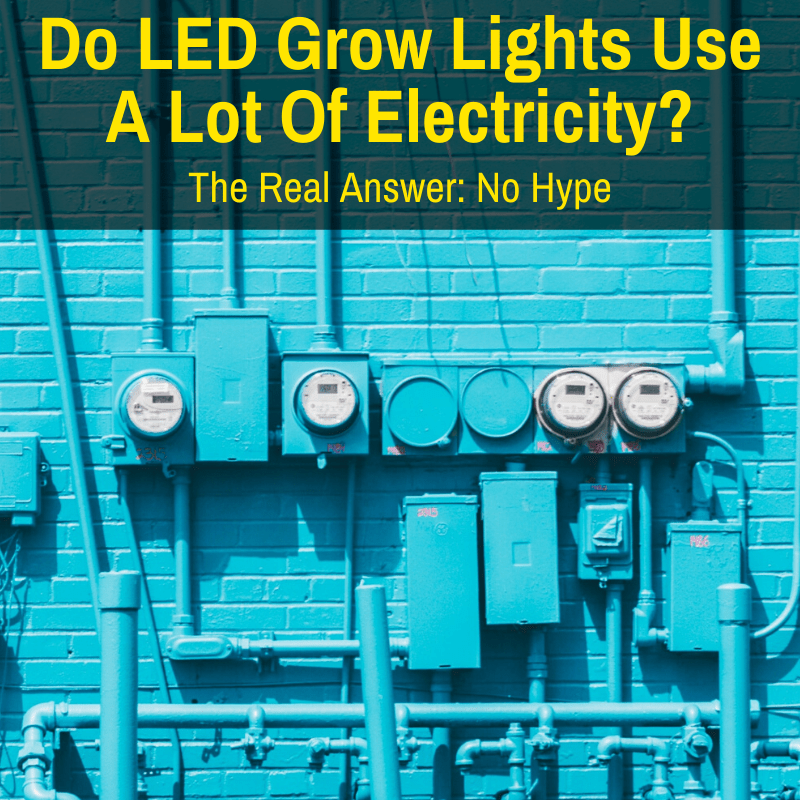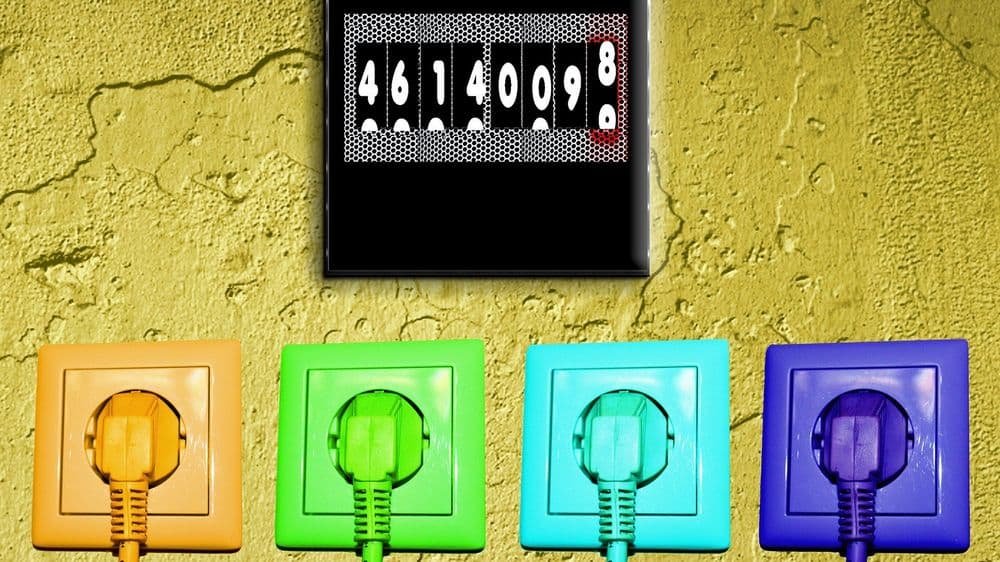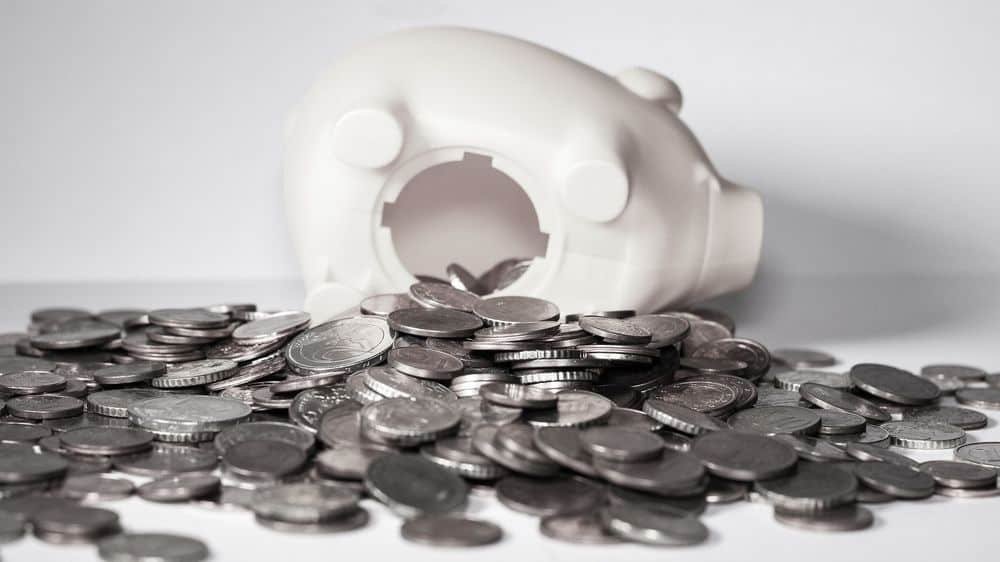 LED grow lights use practically no power, right?
LED grow lights use practically no power, right?
That means they cost virtually nothing to run.
You’ll save so much money!
Sorry to be the bearer of bad news. You’re still going to have an electricity bill.
And if you’ve got a decent sized grow room, you’re going to have a pretty high electricity bill.
So why does everyone keep talking about how much less it costs to run LED grow lights?
Because it does costs less. But people tend to exaggerate. And LED manufacturers REALLY tend to exaggerate.
So let’s take a realistic look at the issue and answer the question once and for all.
Contents
Do LED Grow Lights Use A Lot Of Electricity?
It depends on the light. A powerful LED grow light uses a lot of electricity. But it uses less than other forms of light that give you the same output.
They are more efficient than any other type of lighting, which basically means you pay less in power costs to get the same results. But you will still have a large monthly power bill. It just won’t be as large as it would be with HID lights, or any other type.
How large will it be exactly? Let’s take a closer look.
How Much Electricity Do LED Grow Lights Use?

Calculating how much electricity an LED grow light uses is not that difficult. The hardest part is gathering all the information you need, in order to do the calculation. And that’s not actually hard either, because you only need two pieces of information, both of which are easy to get:
- the actual wattage of the light
- the number of hours the light is running per day
The actual power draw of a light should be easy to find. Any reputable manufacturer will provide this information. Let’s take one of the most popular lights on the market and use it to run through an example. We’ll use the Spider Farmer SF4000. We have a review of the Spider Farmer lights here.
As you can see from the table in that review, the SF 4000 consumes 404 watts. Because power companies use kilowatts (kw) per hour, we need to convert 404 watts to kw/h. To do this, simply divide the wattage by 1000. That gives us a power draw of 0.404 kw/h.
The number of hours the light is running is something you should know, but if you are trying to estimate how much it will cost you to run the light and are not yet sure how long it will run, use the following numbers.
If you are growing marijuana, your lights should generally run for 18 hours per day during vegging and 12 hours per day during flowering.
Many lights have a vegging mode that reduces the power consumption, so you may need to run two calculations: one for vegging and for flowering. The SF 4000 we are using for this calculation, for example, has a dimmer that allows you to reduce the power draw, which is something you might want to do when vegging.
For the purpose of this calculation, we will calculate the power usage during flowering. This means the light is at full power (0.404 kw/h) and it runs for 12 hours per day.
Now we can calculate the kilowatt hours by multiplying those two numbers (0.404 kw/h x 12 hours). That gives us a power consumption of 4.848 kilowatt hours.
We can now use that to figure out the cost to run the light.
How Much Does It Cost To Run An LED Grow Light?

In order to figure out the cost of running a grow light, you need one more piece of information: your electricity rate.
You can find this on your power bill. If you don’t have one or can’t be bothered to look for it, you can also enter your zip code on this site: https://www.chooseenergy.com/electricity-rates-by-state/.
The average price of electricity in the US is 12.83 cents per kilowatt hour, which equals $0.1283 per kwh. We will use this number for our calculation.
That gives us a daily cost of running a 404 watt LED grow light of 4.848 kwh x $0.1283/kwh = $0.622 per day.
To estimate the monthly cost, multiply it by 30. That means the cost to operate this LED grow light is $18.66 per month.
Let’s see how that compares to an equivalent HID light.
How Much Money Does An LED Grow Light Save?
The SF 4000 is about equivalent to an 800 watt HID light, though most people use it to replace a 1000 watt HID system. Let’s go ahead and use the smaller number for this calculation, to err on the cautious side.
We will run through the same calculation again with 800 watts, which is .800 kw/h.
.800 kw/h for 12 hours per day gives us 9.6 kwh.
Using the same cost of electricity, we get a daily expense of 9.6 kwh x $0.1283/kwh = $1.2317.
Our monthly cost is then $36.95.
If we subtract our LED number from above ($18.66) from $36.95, we get a monthly saving of $18.29 for this single LED grow light.
And remember, we used 800 HID watts for this example. If you replace a 1000 watt HID light with the SF 4000, you save even more. Plus, these are just the savings in power costs. LED plant lights actually save you money in other ways as well.
Additional Cost Savings Of LED Grow Lights

A lower power consumption is only one way that LED grow lights save money. They also save due to a lower heat output and a longer lifespan.
Let’s begin with the first one.
A lower heat output means that you will not need to work as hard to keep your grow room cool. You will not need to buy as much ventilation equipment and you will not need as much electricity to power that equipment.
During the summer, HID lights generally require an air conditioning unit. With LED, you may not need it at all, but even if you do need A/C, you won’t need to run it as cold or as often. This results in considerable power savings.
But there is a flip side.
In cold climates, you may need to heat your grow room, if you are using horticultural LED lighting, because you lose the heat from the HID lights. Their heat output is often enough to keep your plants warm in the winter.
More cost savings come courtesy of the lifespan. LED grow lights last much longer than HID lights, and even than fluorescent lights. This longer lifespan means you will not need to change bulbs ever six months to one year.
Good HPS bulbs and MH bulbs are not cheap. The money you save from not having to constantly buy new bulbs really adds up.
Finally, LED plant lights not only save money, they can make you money, too. A big advantage of LED is that you can get the exact spectrum you want and the best manufacturers have tailored their lights with the perfect spectrum for plant growth.
This means that you are not paying the electricity costs for any light that plants ignore (and that thus goes to waste). It also means that your yields will improve, both in terms of size and in terms of quality. Higher quality weed fetches a higher price and obviously, a larger harvest will always result in more money in your pocket.
The key is getting an LED grow light that actually has the ideal spectrum for plants, while also being highly efficient. Let’s take a look at some lights that accomplish both of those.
Which LED Grow Lights Save The Most Money?
Obviously, those that use the least power save the most money. But that is not a useful answer.
What you really want is a light that gives you maximum output while drawing less power. In other words, you want the most efficient possible light. You also want it to have the perfect spectrum for plants.
The most efficient lights on the market today are ones that use COB LEDs and ones that use quantum boards. Both also have a great spectrum.
Which you prefer depends on personal tastes. COBs get better penetration, but quantum boards give you a more even coverage and they run cooler. They also do not need fans, so they are silent.
You can see a rundown on the best COB lights in this post. If you’d rather not read and just want the conclusion, the Phlizon COB fixtures give you the best value for money.
For quantum board lights, Spider Farmer fixtures offer the best value for money. If you don’t mind paying a bit more, Horticulture Lighting Group is the company that popularized the quantum board style of light.
LED Grow Lights Electricity Usage: Final Thoughts
LED grow lights use far less electricity than the equivalent HID, incandescent or fluorescent light bulbs. In other words, for the same output, they use far less input.
And now that LED lights have come down so much in price, to the point where they cost only slightly more than an equivalent HID system (and, in many cases, even less), there is no reason to use HID grow lights any more.
Martin Physics says
“As you can see from the table in that review, the SF 4000 consumes 404 watts. Because power companies use kilowatts (kw) per hour, we need to convert 404 watts to kw/h. To do this, simply divide the wattage by 1000. That gives us a power draw of 0.404 kw/h.”
The units are quite off. “Watts” has dimensions energy per time – thus is a power. You can not consume power. You can consume energy which would be in the case of “kWh” which is “kilo Watt hours” and not “kilo Watt per hour” (kWh not kW/h). And that is what electricity companies use to measure the used energy.
The conversion of 404 watts to kWh would require division by 1000 (as shown) and the duration that the light was running. E.g. in 1 hour the lamp consumes 404 W / 1000 * 1h = 0.404 kWh – which is an amount of energy. The power that the lamp needs is 0.404 kW